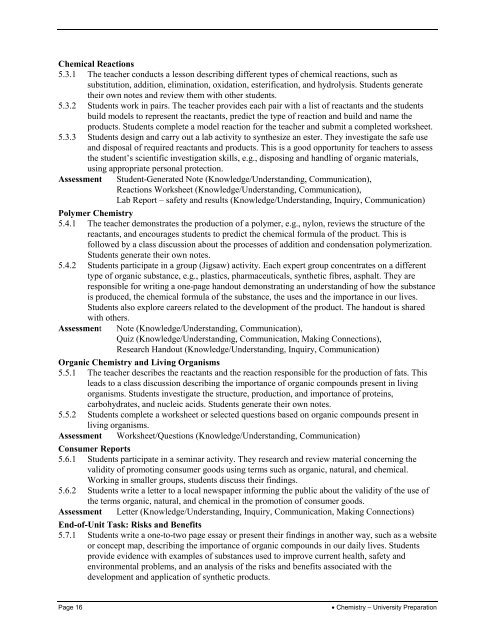Course Profile - Curriculum Services Canada
Course Profile - Curriculum Services Canada
Course Profile - Curriculum Services Canada
Create successful ePaper yourself
Turn your PDF publications into a flip-book with our unique Google optimized e-Paper software.
Chemical Reactions<br />
5.3.1 The teacher conducts a lesson describing different types of chemical reactions, such as<br />
substitution, addition, elimination, oxidation, esterification, and hydrolysis. Students generate<br />
their own notes and review them with other students.<br />
5.3.2 Students work in pairs. The teacher provides each pair with a list of reactants and the students<br />
build models to represent the reactants, predict the type of reaction and build and name the<br />
products. Students complete a model reaction for the teacher and submit a completed worksheet.<br />
5.3.3 Students design and carry out a lab activity to synthesize an ester. They investigate the safe use<br />
and disposal of required reactants and products. This is a good opportunity for teachers to assess<br />
the student’s scientific investigation skills, e.g., disposing and handling of organic materials,<br />
using appropriate personal protection.<br />
Assessment Student-Generated Note (Knowledge/Understanding, Communication),<br />
Reactions Worksheet (Knowledge/Understanding, Communication),<br />
Lab Report – safety and results (Knowledge/Understanding, Inquiry, Communication)<br />
Polymer Chemistry<br />
5.4.1 The teacher demonstrates the production of a polymer, e.g., nylon, reviews the structure of the<br />
reactants, and encourages students to predict the chemical formula of the product. This is<br />
followed by a class discussion about the processes of addition and condensation polymerization.<br />
Students generate their own notes.<br />
5.4.2 Students participate in a group (Jigsaw) activity. Each expert group concentrates on a different<br />
type of organic substance, e.g., plastics, pharmaceuticals, synthetic fibres, asphalt. They are<br />
responsible for writing a one-page handout demonstrating an understanding of how the substance<br />
is produced, the chemical formula of the substance, the uses and the importance in our lives.<br />
Students also explore careers related to the development of the product. The handout is shared<br />
with others.<br />
Assessment<br />
Note (Knowledge/Understanding, Communication),<br />
Quiz (Knowledge/Understanding, Communication, Making Connections),<br />
Research Handout (Knowledge/Understanding, Inquiry, Communication)<br />
Organic Chemistry and Living Organisms<br />
5.5.1 The teacher describes the reactants and the reaction responsible for the production of fats. This<br />
leads to a class discussion describing the importance of organic compounds present in living<br />
organisms. Students investigate the structure, production, and importance of proteins,<br />
carbohydrates, and nucleic acids. Students generate their own notes.<br />
5.5.2 Students complete a worksheet or selected questions based on organic compounds present in<br />
living organisms.<br />
Assessment Worksheet/Questions (Knowledge/Understanding, Communication)<br />
Consumer Reports<br />
5.6.1 Students participate in a seminar activity. They research and review material concerning the<br />
validity of promoting consumer goods using terms such as organic, natural, and chemical.<br />
Working in smaller groups, students discuss their findings.<br />
5.6.2 Students write a letter to a local newspaper informing the public about the validity of the use of<br />
the terms organic, natural, and chemical in the promotion of consumer goods.<br />
Assessment Letter (Knowledge/Understanding, Inquiry, Communication, Making Connections)<br />
End-of-Unit Task: Risks and Benefits<br />
5.7.1 Students write a one-to-two page essay or present their findings in another way, such as a website<br />
or concept map, describing the importance of organic compounds in our daily lives. Students<br />
provide evidence with examples of substances used to improve current health, safety and<br />
environmental problems, and an analysis of the risks and benefits associated with the<br />
development and application of synthetic products.<br />
Page 16<br />
• Chemistry – University Preparation
















